
“Screen time” has become a term that resonates with almost everyone, perhaps especially parents and educators. Defined as the amount of time spent using devices with screens, such as smartphones, tablets, computers, and televisions, screen time is a daily reality for people of all ages.
As technology becomes increasingly integrated into our lives, attempts to understand its impact on cognitive and behavioral development, particularly in children, have sparked concerns and debate.
However, it’s not all bad news. This article aims to shed light on the nuances of this debate, looking at reasonable guardrails and highlighting that limited, quality screen time may actually have beneficial effects on brain development and function.
Let’s explore the relationship between screen time and children’s development and look at how digital interactions influence learning and brain development in today’s youth.
Section 1: Understanding Screen Time
Discussions of screen time in popular media are overwhelmingly negative, and parents are often advised to set hard limits on the amount of time their children spend in front of screens. However, the American Academy of Pediatrics notes that there isn’t enough evidence to demonstrate a clear benefit from these restrictions.
Instead, parents might benefit more from three considerations: the quality of the content, opportunity costs, and the child’s age.
When considering screen time limits, parents might give the quality of the content their children consume one of four labels: passive, interactive, communicative, and creative.
Content that’s wholly passive, in which children mindlessly watch videos or scroll through images, is often made only for entertainment or commercial purposes. While many studies suggest this low-quality content is best limited, some studies show that completely blocking this kind of content may not be for the best.
For example, a Swiss study of more than 7,000 adolescents found that those who reported little to no internet use scored more highly for depression and reported poorer mental health than peers with moderate internet use. Other studies have found that social networking sites can “facilitate psychosocial development” in part by enhancing peer relationships.
Content that’s more interactive — in which children solve puzzles, chat with friends or family, create content, or do schoolwork — is considered higher quality. However, children engaged in these activities should still be monitored to ensure their behavior is positive and the content is appropriate.
At the same time, parents should consider the opportunity costs that come with screen time. An opportunity cost is a benefit or value that a decision causes you to miss. For example, a child who chooses to watch videos on a rainy day when they aren’t feeling well probably isn’t missing out on much else and may even have found a way to cope with feeling poorly.
On the flip side, a child who chooses to watch videos when they could otherwise be outside on a pleasant day, or at an indoor play zone, is missing an important opportunity for exercise and socialization. In short, children need to find a balance between online activities and meaningful, “real-world” experiences.
For very young children — under 18 months — the American Academy of Pediatrics recommends screen time be limited only to video chatting with close family and friends. While children this young may be captivated by a screen with fast-moving images and music, their brains simply aren’t developed enough to get much benefit from it.
For pre-school children, limiting screen time to high-quality programming that an adult engages with them in is recommended. For example, an adult might watch shows with puppets or cartoons that count, name shapes, or spell words, and help the child guess at the words and sound them out.
As children get older, monitoring their screen time to ensure their use is age-appropriate and isn’t upsetting the child, and negotiating a balance that feels right for your family, is best.
Section 2: A Meta-Analysis
Collectively, doctors, scientists, educators, and parents recognize the potential risks and benefits of screen time on childhood development and cognition. While some amount of even low-quality content can help develop social bonds, excessive screen time has also been associated with cognitive, executive function, and behavioral problems, as well as lowered IQ.
However, it’s not all doom and gloom. High-quality screen time can enhance IQ, boost academic success, improve literacy skills, increase visual-spatial awareness, sharpen problem-solving abilities, and foster social connections, along with other positive outcomes.
A meta-analysis of studies reveals a spectrum of outcomes and methodologies. Studies tend to focus on certain age groups and populations, and findings are usually qualified by discussions of the time spent on screens as well as the quality of the content.
A Brief Analysis of Studies with Positive Findings
Numerous studies show a positive correlation between appropriate screen time and IQ and academic performance. Perhaps unsurprisingly, content that is made to be educational is most positively correlated with improved performance. Particularly when it’s thoughtfully implemented into classrooms, technology can increase academic performance and engagement, and close achievement gaps for at-risk students.
Exposure to educational material like Sesame Street before age 7 has been correlated with improved academic achievement and long-term positive outcomes. Over a two-year period, children who spent more time on average playing video games improved their IQ test scores by 2.5 more points than their peers. Video games have also been correlated with improved literacy, visual-spatial awareness, problem solving, and social connections, among other benefits.
A Brief Analysis of Studies with Negative Findings
While some studies show screen time may have benefits for intelligence and academic performance, other studies show that there is cause for limits and guardrails. A study published in JAMA Pediatrics, for example, correlated above-average screen time at 12-months with developmental delays in communication and problem-solving as much as 3 years later. Other studies have correlated worrisome physical changes in the brain’s structure with heavy screentime.
Prolonged use of screens has also been correlated with decreased organization of the brain’s white matter, which supports language and literacy. In this study, participants with more screen time performed less well on cognitive tests.
Other studies have linked the use of phones and mobile devices in early development with delayed speech development, decreased executive functioning, and hyperactivity and inattention in classrooms. In addition, research indicates that spending too much time on screens can affect brain function, leading to shorter attention spans and increasing feelings of loneliness, depression, and anxiety. It also has been linked to lower academic achievement in kids.
Possible Conclusions
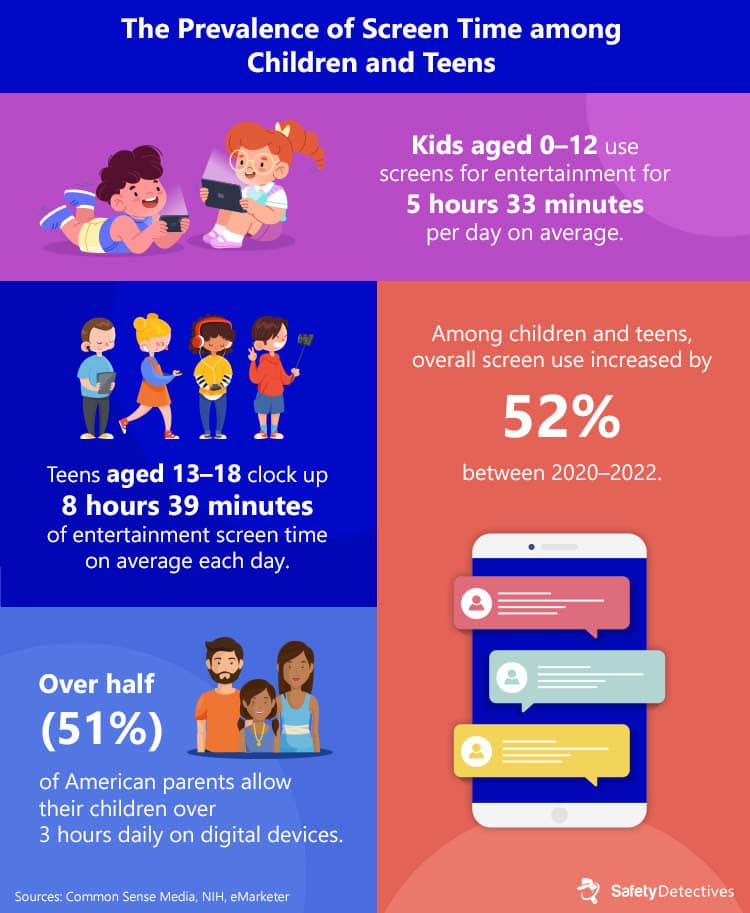
Recent statistics shed light on the screen time habits of children in different age groups, highlighting a trend of increasing screen exposure as children grow older. On average, kids aged 0–12 use screens for entertainment for 5 hours 33 minutes per day. This figure sees a significant jump in the 8-10 year age group, where children in the United States spend an average of 6 hours a day in front of a screen.
Furthermore, over half (51%) of American parents let their children spend more than 3 hours per day engaging with digital devices. These statistics underscore the growing prevalence of screen time in children’s daily routines and the importance of understanding its impact on their development.
We can compare these statistics to the amount of screen time recommended by the American Academy of Pediatrics and to how prolonged screen time is correlated with worse outcomes in many studies. When we do, what we see is that many households allow children to use screens for longer than recommended, and to an extent that may impact their development and academic careers.
Section 3: Neurological Implications of Screen Time
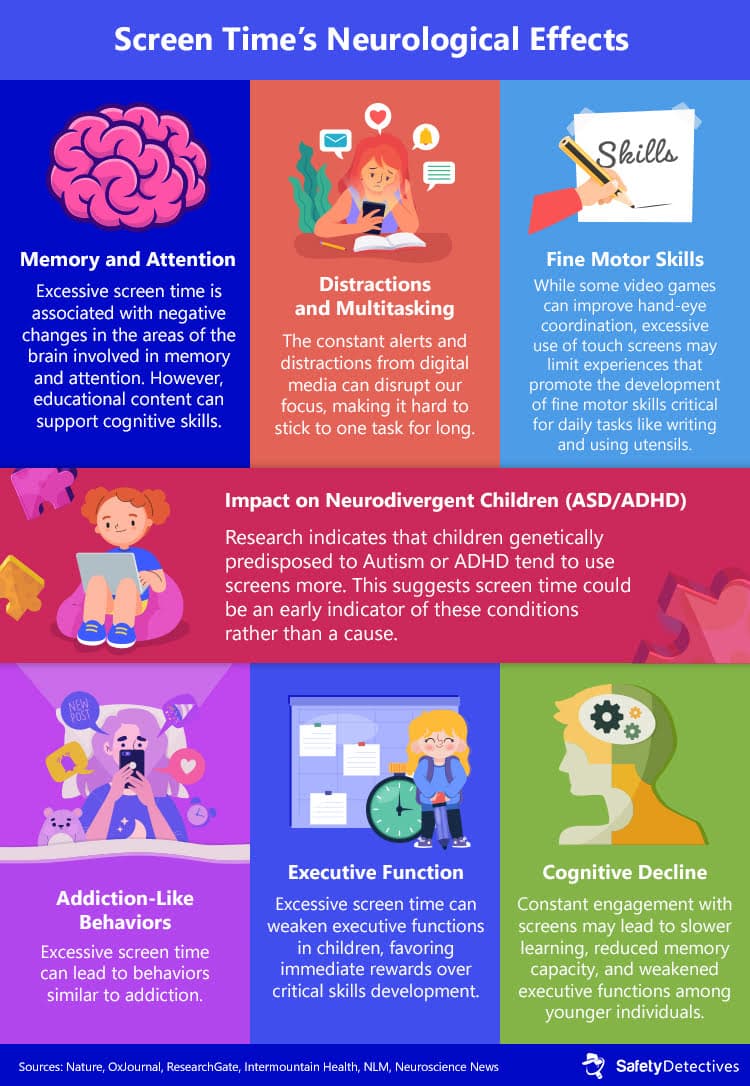
The relationship between screen time and neurological development is a subject of considerable debate within the scientific community. Research indicates that screen time’s impact on the brain is neither entirely harmful nor wholly beneficial. Many studies conclude by highlighting the importance of moderated and intentional use of digital media, taking into consideration individuals’ diverse needs and developmental stages.
Current studies suggest that the influence of screen time on neurological development varies significantly among different age groups. Children and adolescents require particular attention to keep them off-screen. For these younger individuals, whose brains are in critical growth phases, the content and context of screen time are pivotal.
Memory
Screen time, particularly in excessive amounts, has been shown to negatively impact memory and other cognitive functions in children. Studies have highlighted that engaging in activities on screens for prolonged periods can interfere with the brain’s processes related to attention, memory retention, and the ability to switch between tasks efficiently.
Furthermore, high levels of screen time have been associated with structural changes in the brain, including areas involved in memory and attention, indicating that the digital environment could be reshaping the neural pathways critical for memory development.
Conversely, parents should recognize that not all screen time is detrimental to memory development. As mentioned above, educational content can support cognitive skills, including memory, by providing interactive and engaging learning experiences that reinforce memory retention through repetition, feedback, and the application of new knowledge in various contexts.
Attention
While many people report feeling that the constant distractions of digital media are causing their attention spans to shrink, the reality is a bit more complicated. As Gloria Mark, doctor of psychology and professor of informatics at the University of California discusses, there are different kinds of attention, and our ability to give focused attention is cyclic throughout the day.
It’s not that we lack the ability to focus when we need, but the constant alerts and the temptation to check our devices can make it hard to stick to one task for long. Often, we end up looking at our phone’s notifications or checking email, which can break up our focus.
A study out of Oxford suggests that adults might experience decreased attention due to screen usage for several reasons. These include the anxiety of missing out on social events or news (often referred to as FOMO), the constant interruption from notifications on devices, and becoming overly dependent on technology for tasks that require memory, such as using apps for reminders instead of remembering them independently.
When it comes to children, digital media has been shown to activate the same neural pathways as addictions, releasing dopamine as a “neural reward” for engaging with devices. Short-form videos, for example, provide constant streams of new information with each video potentially triggering a release of dopamine.
Engaging with this content can train a young person’s brain to abandon situations in which information isn’t being presented quickly enough, in effect decreasing the child’s attention span.
However, the same Oxford study notes that technology can also be used to improve a child’s attention span and aid in learning, in part by providing more individualized educational experiences.
It was also found that children who played video games for less than an hour a week were seen to have “more control of their cognitive activities” than peers who did not play video games, likely due to overlapping areas of the brain that are activated while gaming that also affect attention. So not all of the news about screen time, attention span, and academic performance is bad.
Trying to do many things at once with our gadgets, like watching a video while texting, might seem smart, but it actually can make it tougher for us to understand and remember what we’re learning and can increase feelings of stress. This isn’t about losing our ability to pay attention; it’s more about the choices we make when we’re surrounded by so many distractions.
By figuring out how to handle these distractions — like making a plan for when to focus on just one thing and when it’s okay to switch between tasks — we can better control our attention and do a better job both online and off.
Fine Motor Skills
Fine motor skills involve the coordination of small muscles, particularly those involving the synchronization of hands and fingers with the eyes. Neurologically, these skills are controlled by various regions of the brain, including the motor cortex, cerebellum, and basal ganglia, which coordinate muscle movement, strength, precision, and timing. The development of fine motor skills is critical for everyday tasks such as writing, buttoning clothes, and using utensils.
Some studies suggest that excessive time using touch screens, for example, may limit the diversity of experiences that promote the development of fine motor skills, especially in children whose brains are in critical developmental stages.
Other research shows that playing certain kinds of video games, perhaps especially action-oriented games, can strengthen the neural connections necessary for fine motor skills. When you play games that require accuracy and can be practiced over and over, your hands can become more skilled and quick. This can help you with things like writing, drawing, and playing sports.
As with most things, being both thoughtful and intentional in the use of screens may be for the best. While there are some benefits of certain kinds of screen time on motor skills, interactions with physical objects, crafts, drawing, and outdoor play are essential for developing fine motor skills that digital interactions alone cannot fully support.
Addiction
Screen time, especially when excessive, can lead to addiction-like behaviors, which are deeply rooted in the brain’s neurological pathways. The continuous use of digital devices and engagement with various forms of media can activate the brain’s reward system, releasing dopamine — a neurotransmitter associated with feelings of pleasure and satisfaction.
Much online content — for example, short-form videos — is meant to create a cycle of stimulus and reward that can strengthen neural connections that promote compulsive behavior patterns akin to those observed in substance addiction.
The instant gratification obtained from screen interactions can condition the brain to desire more screen time, leading to a dependency that can be hard to break. This is particularly concerning as it can affect the brain’s frontal lobe, responsible for decision-making, impulse control, and self-regulation, thus impairing an individual’s ability to moderate screen use and prioritize tasks effectively.
Executive Functioning
Research has indicated that extensive use of screen-based media, from early childhood through adolescence, can negatively impact the brain’s executive functions — skills crucial for planning, decision-making, problem-solving, and impulse control.
Studies tracking young children have shown that higher amounts of screen time at an early age can hinder the development of these critical cognitive abilities over time. This is partly because engaging with screens often involves rapid, reward-based interactions that condition the brain to favor short-term gratification over more substantial, long-term goals.
Additionally, the sedentary nature of screen time and its ability to monopolize attention can detract from activities that nurture executive functions, such as physical play, reading, and interactive learning experiences.
Cognitive Decline
Studies indicate that constant engagement with screens may lead to slower learning, reduced memory capacity, and weakened executive functions among younger individuals. These effects can contribute to academic challenges and may reduce the brain’s ability to resist age-related cognitive decline.
The long-term implications of excessive screen time, including the heightened risk of early-onset dementia and other neurodegenerative conditions, emphasize the importance of moderated digital consumption. In a study of more than 450,000 participants, researchers found that watching TV 4 or more hours a day increased the risk of all negative outcomes they tested for.
At the same time, using a computer for non-work activities for between 30 minutes and an hour decreased the risk of all negative outcomes.
When participants replaced 30 minutes of TV viewing or computer activity in excess of 1 hour with physical activity, their risk for dementia and depression decreased substantially.
Neurodivergence (ADHD/ASD)
Researchers in Japan studied how kids with a genetic predisposition for Autism (ASD) or ADHD use screens like tablets and TVs. They examined the genetic profiles and behaviors of 437 kids to see if they could find a link between markers of neurodivergence and how the children used screens.
They found that kids with more markers for ASD tended to use screens more even at very young ages. Kids at greater risk of ADHD tended to increase their screen use as they got older.
This study suggests that screen use likely isn’t a causal factor in developing ADHD or ASD. Rather, certain patterns of screen use may be an early indicator of these disorders.
When interviewed, the researchers cautioned that neurodivergent children are more at-risk than their neurotypical peers of having too much screen time, perhaps increasing their risks of addiction to the devices.
Section 4: Impact on Communication Skills and Language Development
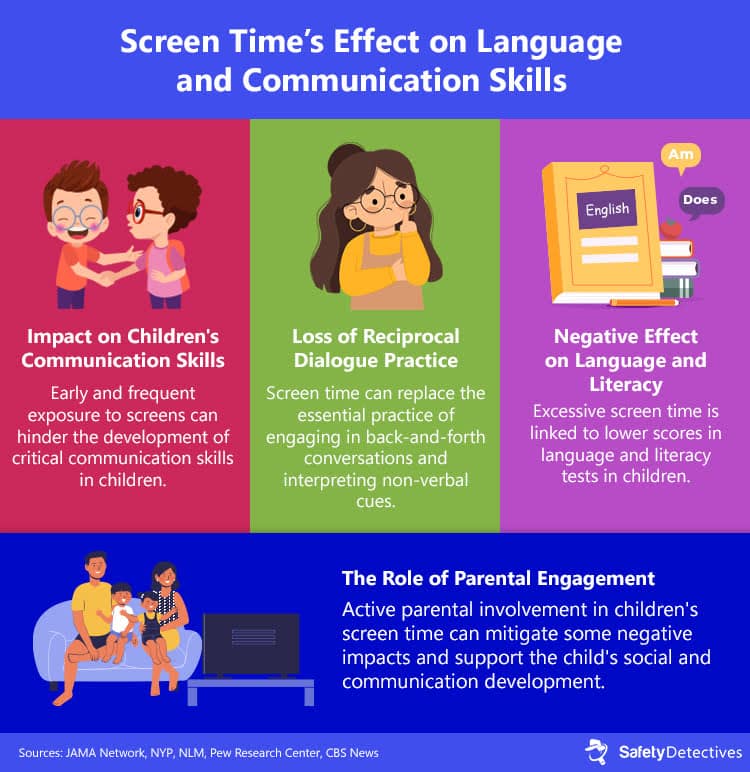
The pervasive use of screens is reshaping our communication skills and language development, particularly among young adults who often struggle with face-to-face interactions after growing up with a great deal of digital engagement. Encouraging activities that promote direct human interaction over digital consumption is crucial during a person’s formative years.
Communication
Recent findings reveal that early and frequent screen time can significantly hinder children’s communication skills in several ways. Excessive screen exposure during critical years (2-5) of brain development may lead to long-term deficits in essential interpersonal and motor skills, as well as in language and socioemotional health.
As screens replace human interaction, children may miss out on the vital practice of engaging in reciprocal dialogue and interpreting facial expressions and body language, all of which are foundational for effective communication and social interaction.
Furthermore, research indicates a link between screen time and the structural integrity of brain areas associated with literacy and language. Children who spend considerable time in front of screens exhibit lower scores in language and literacy tests, suggesting that digital media consumption could be compromising the development of these critical skills.
Language Development
Screen time has implications for language development. Reciprocal dialogue is important in fostering linguistic and social abilities. Engaging children in back-and-forth conversations, sharing facial expressions, and responding to each other in person are critical components of this process.
These interactions, unlike passive listening or one-sided communication with screens, are instrumental in enhancing young children’s language and communication skills.
Parental Engagement
Research also emphasizes the role of parental engagement in mitigating the potential downsides of screen time. By actively participating in their children’s screen time, parents can transform it into a bonding experience.
Discussing content, addressing age-inappropriate material, and using screen time as a springboard for conversation and learning can enhance its value. This approach not only enriches the child’s experience but also supports their social and communication development.
Section 5: Impact on Physical Activities and Learning
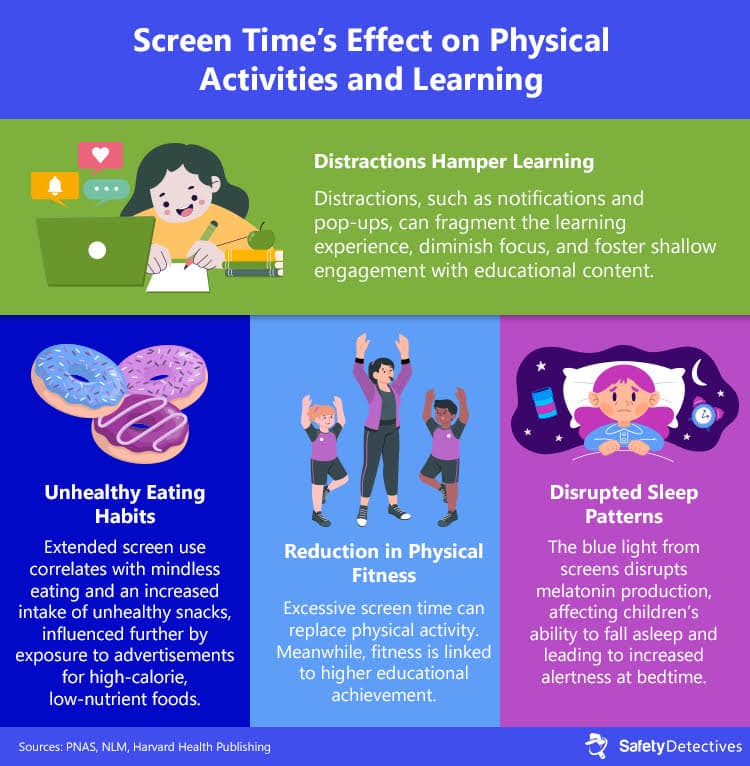
Screen time can both help and hurt learning. If the content is high quality and educational, it can make learning fun and help kids understand new things. However, too much screen time can lead to distractions like pop-ups or the urge to check out games and social media, which can break concentration and make it hard to really learn and think deeply. Let’s see how screen time affects these areas.
Education and Learning
Screens introduce significant distractions — notifications, pop-ups, and the ever-present temptation of entertainment or social media — that can fragment learning experiences. Such interruptions can diminish focus and promote a shallow engagement with educational content.
Furthermore, the fast-paced and concise nature of digital information might not adequately nurture critical thinking and deep analytical skills, essential for comprehensive learning. A clear example of this is scrolling through social media.
Physical Activity
Recent studies have linked physical fitness at a young age, particularly by the age of 18, to educational achievement later in life. Excessive screen time, by contrast, detracts from physical activity. Children and teens spending more free time on screens could miss out on these benefits.
The issue here is the displacement of physical activities by screen time, which potentially fosters a sedentary lifestyle that heightens obesity risks. Children engaged in passive screen viewing are missing out on essential fine motor skill activities, such as walking, running, and outdoor play, which could delay developmental milestones.
Furthermore, extended screen use correlates with mindless eating habits and an increased intake of unhealthy snacks, exacerbating the risk of weight gain. Exposure to advertisements for high-calorie, low-nutrient food and beverages can also shape children’s and adolescents’ dietary preferences, steering them toward unhealthy eating patterns that contribute to obesity.
Sleep
The blue light emitted from screens poses another concern by disrupting melatonin production, the hormone responsible for regulating sleep cycles. This interference can make falling asleep at night a challenge.
Engaging with screen time before bedtime can heighten alertness and delay sleep onset. Moreover, excessive screen use, especially in the evening, is linked to shorter sleep durations and diminished sleep quality. The consequences of poor sleep extend beyond immediate restlessness, affecting overall health, cognitive function, and learning capabilities.
Section 6: Guidelines for Managing Children’s Screen Time
While screens can be beneficial, their use should be balanced with other activities. Completely banning or heavily limiting screen time may be counterproductive. Oppositional behaviors are common in teens, and setting hard limits may lead to children rebelling against them.
Instead, setting ground rules and encouraging healthy habits is key. By creating a balanced approach to screen time, children can enjoy the benefits of technology while also engaging in physical, social, and creative activities essential for their overall development. Balanced guidelines may include:
- Set Clear Limits: Establish daily or weekly screen time limits that are appropriate for your child’s age and needs. Consider screen-free times, such as during meals and before bedtime, to encourage healthy routines.
- Choose Quality Content: Opt for educational and age-appropriate content that promotes learning and creativity. Encourage programs that involve music, movement, and storytelling, which can be beneficial for children’s development.
- Engage Together: Whenever possible, engage in screen content with your children. This allows you to monitor what they’re viewing and also gives you the opportunity to discuss the content, helping them understand and relate it to the world around them.
- Promote Active Participation: Encourage your child to interact with the content through questions, discussions, and related activities. This active engagement helps deepen their understanding and makes screen time more meaningful.
- Encourage Other Activities: Ensure that screen time does not replace critical developmental activities. Reading, playing, and engaging in problem-solving activities are crucial for a child’s growth. Encourage a mix of these activities to foster a well-rounded development.
- Lead by Example: Children mimic adult behavior. By demonstrating balanced screen use and engaging in various activities yourself, you set a positive example for your children to follow.
Age-Determined Guidelines
In an effort to guide parents and caregivers through digital media, the American Academy of Pediatrics (AAP) offers age-appropriate guidelines to help manage children’s screen time effectively. These guidelines serve as a foundation for building healthy screen habits that can support a child’s growth and development at various stages of their lives.
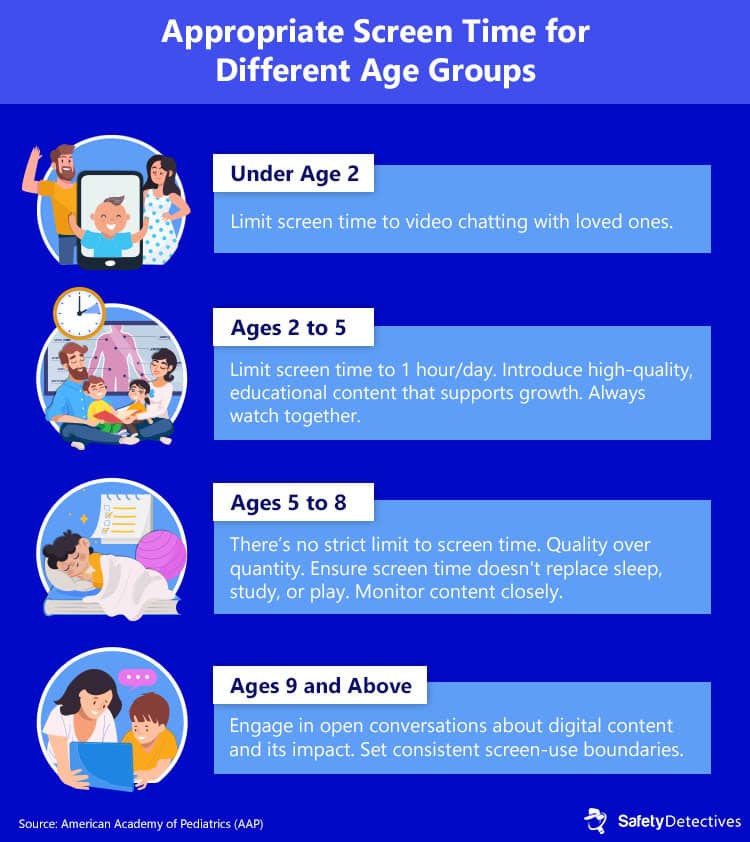
To implement these guidelines, parents and caregivers need to learn to set clear rules, engage in open dialogue, and lead by example. By providing a structured approach to screen time, parents can help their children navigate the digital world in a way that promotes their well-being and development.
The aim is to use technology as a tool for learning and connection rather than a barrier to personal growth and family interaction.
Tips for Limiting Screen Time
I’ve reviewed sources, including scripps.org and mayoclinichealthsystem.org, and compiled some of their best tips for limiting screen time:
- Establish Boundaries: Creating a healthy digital environment starts with clear communication. Establishing clear expectations about screen time with your children is crucial. Set achievable goals to consciously reduce screen time and make use of device features that allow you to limit usage time. This could include setting up app limits, downtime schedules, or using parental control software to help manage and monitor screen use effectively.
- Store Hand-Held Devices Properly: To resist the constant pull of screens, store hand-held devices out of sight during designated screen-free times. Place them in a common charging area or another designated spot. This minimizes temptation and helps reinforce the boundaries you’ve set around screen time, making it easier for everyone to stick to the plan.
- Establish Phone-Free Areas: Creating phone-free zones within your home can significantly reduce screen time and improve family interactions. Start with the dining area, declaring it a no-phone zone to encourage family time during meals without the distraction of screens. This simple step can help foster better communication and connection among family members.
- Encourage Outdoor Activities or Unstructured Playtime: Encouraging your family to put down their devices and engage in outdoor activities or unstructured playtime is beneficial for both mental and physical health. Outdoor activities boost endorphins, leading to a happier mood, and contribute positively to physical health. Whether it’s a bike ride, a game of catch, or a walk in the park, these activities provide valuable opportunities for family bonding and exercise.
- Keep Screens Out of Your Child’s Bedroom: One effective strategy for ensuring that screen time doesn’t interfere with sleep is to require that children charge their devices outside of their bedrooms at night. This helps avoid the temptation for late-night scrolling and helps ensure that your child gets a restful night’s sleep, which is essential for their overall health and well-being.
- Participate in Screen Time Together: Joining your children during their screen time can be more than just monitoring; it’s an opportunity for bonding and learning. By watching shows or playing games together, you can directly guide their understanding and interpretation of what they’re seeing. Discuss the content actively, ask questions, and engage in activities like singing along to music.
- Encourage Digital Literacy: Teaching your child to critically assess the content they encounter online is fundamental to developing responsible digital habits. This includes understanding the impact of their technology use, recognizing the reliability of online information, and being aware of how personal data may be collected and used. Encourage older children to think about the credibility of websites and to recognize that all media content is created with certain perspectives and biases.
- Be Selective with Media Choices: Making informed decisions about the media your children consume is crucial. Resources like Common Sense Media offer reviews and recommendations for age-appropriate apps, games, and shows, helping parents select content that is educational, entertaining, and aligned with their family’s values. These guides are invaluable tools for curating a media diet that supports healthy development.
- Use Technology to Limit Screen Time: Leveraging technology itself can help manage and monitor screen time effectively. Home internet routers, security systems, and features on gaming consoles and computers can restrict usage times and content access. Additionally, companies like Apple and Google provide settings and tools designed to track and limit screen time. While these technological solutions offer control, you should balance them with open communication to avoid driving behavior underground.
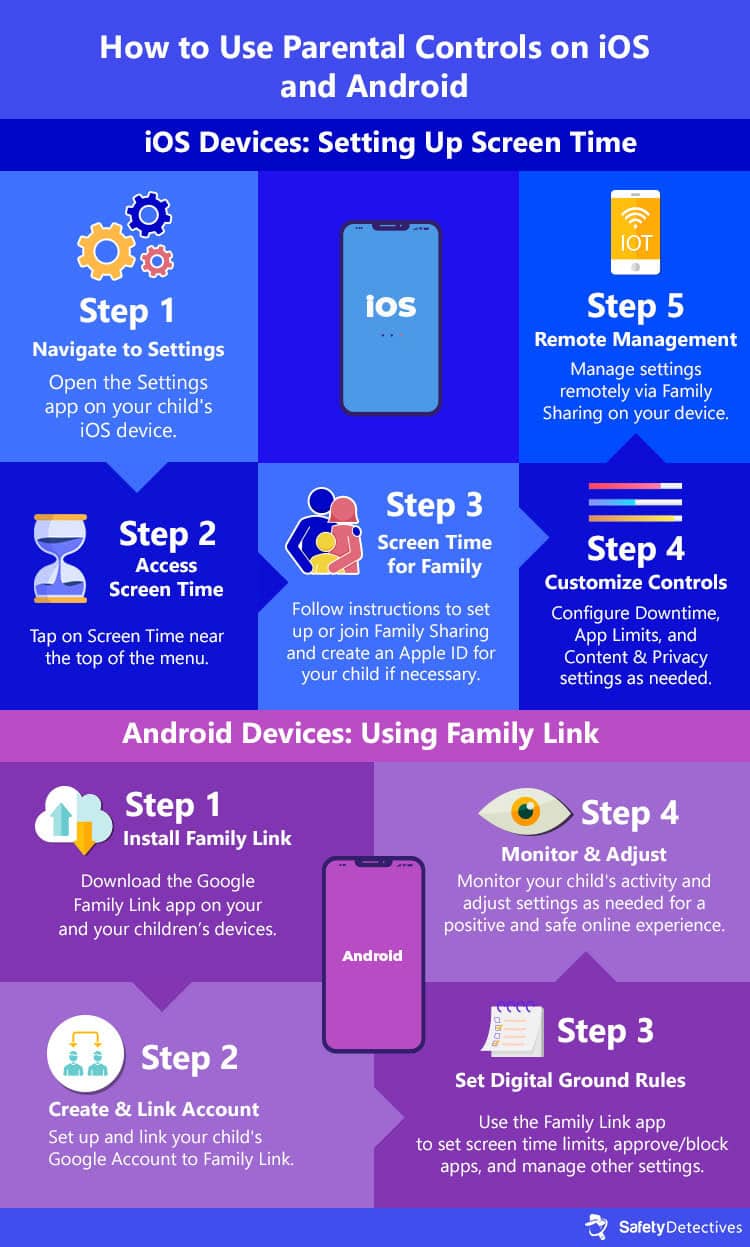
Monitoring Apps and Services
For more personalized control, third-party apps like Qustodio, Norton Family, or Net Nanny offer comprehensive monitoring and management features. Built-in parental controls, such as iOS’s Screen Time and Android’s Family Link, also provide ways to oversee and limit screen use.
These tools can help parents tailor the digital environment to their child’s needs, promoting a healthy balance between screen time and other activities. However, the key to effective use of these tools is maintaining trust and communication, ensuring that children understand the purpose behind monitoring and feel comfortable discussing their online activities.
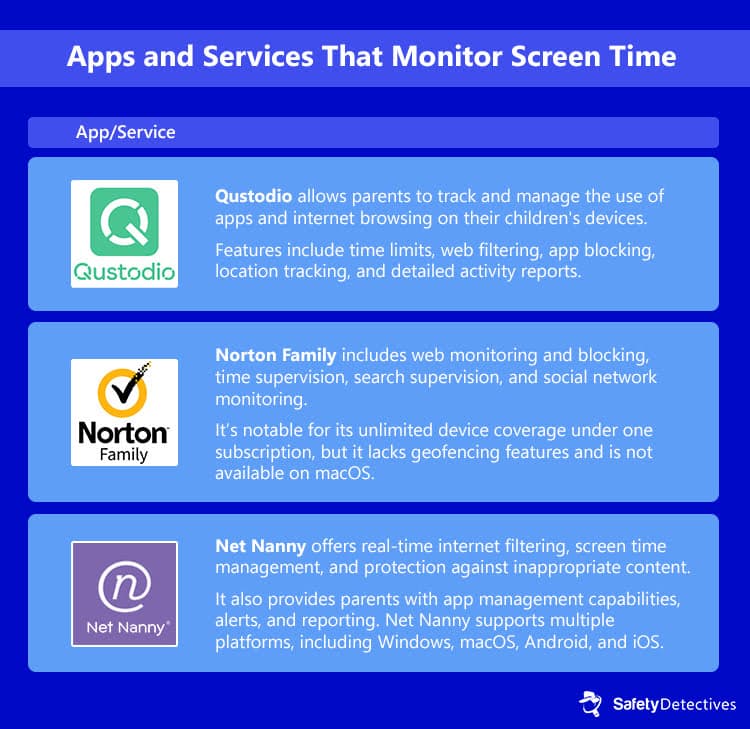
Using these built-in parental controls provides a framework for responsible device use, allowing children to explore and learn online while maintaining necessary boundaries. These tools empower parents to support their children in developing healthy digital habits.
Concluding Insights
Screen time is a double-edged sword. Research has illuminated that not all screen time is detrimental; however, its impact on children’s IQ, communication skills, and cognitive abilities cannot be overlooked.
The quality of content children are exposed to plays a pivotal role in determining the effects of screen time. High-quality, educational, and engaging content can be beneficial provided it’s consumed in moderation.
The importance of limiting screen time for children is underscored by the potential positive outcomes. By setting boundaries around screen use, children can experience enhanced cognitive development, improved focus, better communication skills, and more opportunities for creative and physical play. These real-world activities are crucial for holistic development, fostering skills that screen time alone cannot provide.
Furthermore, parents play a crucial role in setting the standard for healthy screen habits. By managing your own screen time, you’re adhering to best practices while also modeling behavior for your children. Demonstrating a balanced approach to screen use, prioritizing face-to-face interactions, and engaging in physical and creative activities can inspire your children to follow suit.
By establishing and modeling these healthy habits, parents can help their children achieve a balanced digital and real-world experience, contributing positively to their IQ development and overall well-being.